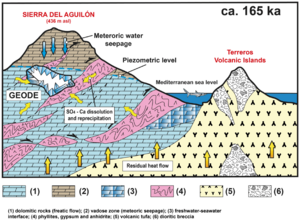Pulpí Geode facts for kids
The Pulpí Geode is a giant crystal cave found in Spain, near the town of Pulpí. It was discovered in December 1999 and is one of the largest geodes ever found in the world! Imagine a huge hollow rock lined with amazing crystals – that's what a geode is. This special geode is located deep inside an old mine.
Contents
Discovering the Giant Pulpí Geode
The Pulpí Geode was discovered by Javier Garcia-Guinea in December 1999. He was part of the Madrid Mineralogist Group. This amazing find happened near the town of Pulpí, in the Almería region of Spain. The geode is hidden about 50 metres (160 ft) deep inside the Pilar de Jaravía mine. This mine is in the Sierra del Aguilón mountains, about 3 kilometres (1.9 mi) from the coast.
What Makes the Pulpí Geode Special?
This geode is truly unique because of its huge size. It's like a giant crystal room! The geode is about 10.7 cubic metres (380 cu ft) in volume. It measures 8 by 1.8 metres (26.2 by 5.9 ft) and is about 1.7 metres (5 ft 7 in) tall on average.
What makes it even more special are the crystals inside. The geode is lined with beautiful, clear selenite crystals. Selenite is a type of gypsum mineral. These crystals are incredibly transparent and perfect. Some of them can be as long as 2 metres (6 ft 7 in), though most are around 50 centimetres (20 in).
The geode has a fun, funnel-like shape. Its narrowest part is shaped like the letter 'L'.
Visiting the Pulpí Geode Today
The mine where the geode was found used to be a silver-lead mine, but it is now abandoned. Today, the Pulpí Geode is a special geoheritage site. This means it's a place important for its geology. Many people who love geology, called geotourists, come to visit it.
Sadly, the geode was slightly damaged by vandals at the end of 2021. However, the damage was not as bad as people first thought.
How the Pulpí Geode Formed
Scientists have studied the Pulpí Geode to understand how it was created. The latest research was published in March 2022. This study was led by Fernando Gázquez from the University of Almeria.
The research suggests that the selenite crystals inside the geode formed a very long time ago. This happened between 164,000 and 60,000 years ago, during a period called the upper Pleistocene. The crystals grew from fresh water that was underground, in an aquifer. Scientists found very little evidence of salty or sea water, which was a different idea some people had before.
See also
In Spanish: Geoda de Pulpí para niños



